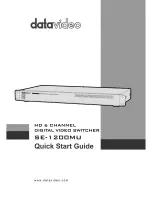
32
SERVSWITCH™ ULTRA
When you’re ready to begin hooking up the actual units, follow these steps:
1. If this hasn’t already been done, connect the monitor(s), keyboard(s), and
mouse (mice) to the MONITOR/KEYBOARD/MOUSE port(s) of your
master device(s) as outlined in
Section 3.2.2
.
2. Use ServSwitch-to-ServSwitch Expansion Cables (see
Section 3.2.4
) to connect
all your submaster units to the master unit’s CPU ports, beginning with the
port labeled CPU 1 and continuing with CPU 2, CPU 3, etc. (Avoid installing
submasters with different numbers of CPU ports on the same master; if
possible, every Serv unit in your cascade should have the same number of
ports.)
3. Using CPU Adapter Cables, attach your computers to available CPU ports: the
first computer into the port identified as CPU 1, CPU #2 into its port, etc. (see
Section 3.2.3
). The computers should all be OFF; do not turn them ON yet.
4. Attach the power supplies to the master(s) and to the submasters. Plug in the
power supplies, but do not turn the master(s) or submasters ON.
5. Turn ON all of the submaster units, then the master unit(s). They should
boot normally, but if the firmware in any of the units has become corrupted—
probably as the result of a firmware upgrade going wrong—the affected unit
will display this message on all attached monitors that have it selected:
Kernel is bad, load new kernel through serial port
If you see this, you will need to download correct firmware to the affected unit
as described in
Section 4.4.3
, starting at the point at which the unit is ready to
receive the file at 9600 baud (9600 bps). (In this case, you
must
download the
file at 9600 bps.)
6. If all of your computers are Sun type, see
Section 3.2.5
for the power-up
procedure for your CPUs. Otherwise, turn ON the computer identified as
CPU 1. Wait until the boot process is complete, then turn ON CPU 2, wait
until it boots, turn ON CPU 3, etc., until all of your computers are powered
up.
7. Set each master’s Maximum computers, Expansion units, and Expansion
width values so that the master can scan correctly and properly control the
interplay of the submaster units. You can do this with the on-screen display—see
Sections 5.2.3
through
5.2.5
.
















































